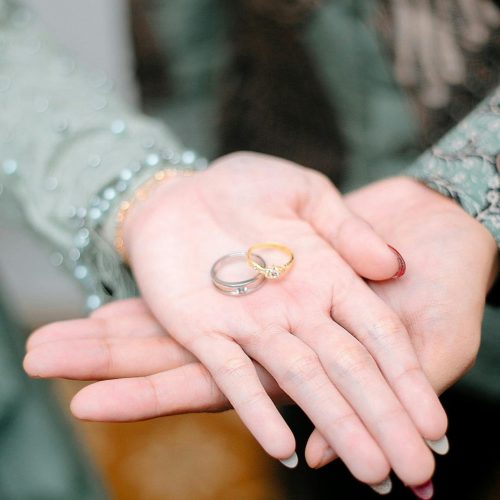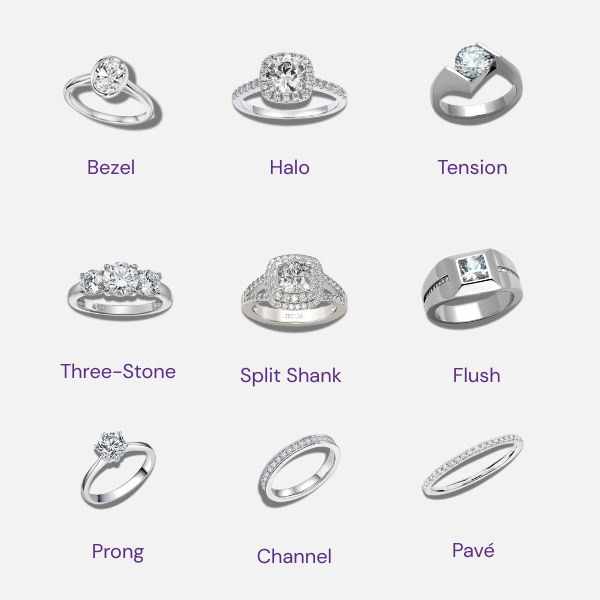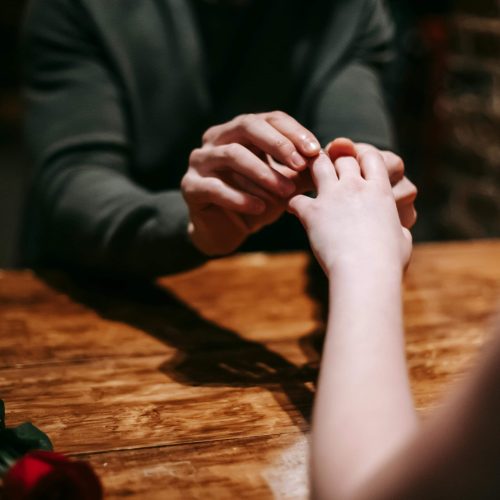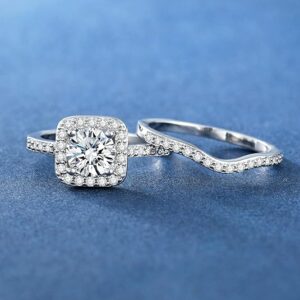Buying an engagement ring is a big moment. It’s not just a piece of jewelry—it’s a symbol of love, commitment, and the start of a new chapter. But let’s be real, it’s also a big decision.
This ring should match your partner’s style, feel personal, and be something they’ll treasure forever. You’ll want to think about the gemstone’s quality, the ring setting, and the metal type. Don’t forget the ethical side—many couples today care about responsibly sourced stones.
In this guide, we’ll cover:
- The 4Cs of diamonds
- How to choose the right setting
- Tips on budgeting
It may seem like a lot, but we’ll make it easy. Let’s get started.
Table of Contents
Step 1: Set a Realistic Budget
When you’re about to buy an engagement ring, the first question that usually comes up is, “How much should I spend?” Forget the old, outdated “three-month salary” rule—it’s time to break free from that myth. The truth is, your budget should be based on what feels right for you, your partner, and your financial situation.
What Matters Most to You?
- Do you want a larger diamond, or is a unique design more important?
- Want something classic or a statement piece?
Budget-Friendly Options:
- Lab-grown diamonds: These diamonds are chemically identical to mined ones, but they come at a more affordable price and are an eco-friendly choice.
- Colored gemstones: Consider alternatives like sapphires, emeralds, or rubies. These stones are beautiful, unique, and often less expensive than traditional diamonds.
Tip: The value of the ring isn’t in the price—it’s the love and commitment it represents.
Step 2: Understand the 4Cs of Diamonds
When buying a diamond, there are 4 key things to know: cut, clarity, color, and carat. These affect the diamond’s look and price.
- Cut: This affects how much the diamond sparkles. Aim for a grade of Excellent or Very Good for the best shine.
- Clarity: This is about the tiny flaws inside the diamond. Diamonds with VS1 or VS2 clarity look almost perfect to the eye.
- Color: Diamonds range from colorless (D) to yellow (Z). G-H diamonds are nearly colorless and offer great value.
- Carat: This measures the diamond’s weight. A well-cut diamond may look larger than one with a higher carat but poor cut.
Balance Tip:
Focus on cut for the best sparkle. You can adjust clarity, color, and carat to match your budget. A well-cut G-H diamond with VS clarity can look beautiful and be more affordable.

Step 3: Choose the Right Center Stone
The center stone is the focal point of the engagement ring, and choosing the right one can feel like a big decision. While diamonds are the traditional choice, other stunning stones like sapphires, rubies, emeralds, and lab-grown diamonds have become increasingly popular for their beauty, uniqueness, and sometimes more budget-friendly prices.
Let’s dive into the options to help you pick the perfect center stone for your engagement ring.
- Diamonds: Represent love and eternity. Stick to the 4Cs (cut, clarity, color, carat) to find the best one.
- Sapphires: Symbolize wisdom and loyalty. They’re durable and perfect for everyday wear.
- Rubies: Represent love and passion. Their deep red shades are gorgeous and highly durable.
- Emeralds: Represent renewal. They’re softer than diamonds, so they need extra care.
- Lab-Grown Diamonds: Identical to natural diamonds but more affordable, ethical, and environmentally friendly.
Tip: How to Choose Based on Taste, Values, and Budget
- Traditional: Go for a diamond.
- Eco-conscious: Lab-grown diamonds or colored gemstones like sapphires and rubies.
Pro Tip: If unsure, ask your partner subtly or even shopping together.
Step 4: Find a Ring Style That Matches Their Personality
Choosing the right ring style is just as important as picking the perfect stone. After all, the style of the engagement ring should reflect your partner’s personality and taste. Whether they’re into classic designs or something a bit more modern, you want a ring that feels as unique and special as they are.
Let’s explore some popular engagement ring styles and how to pick the one that best matches their style.
- Solitaire: A single center stone, ideal for those who love simplicity and elegance (e.g., Kate Middleton’s sapphire ring).
- Halo: A center stone surrounded by smaller diamonds for extra sparkle, perfect for someone who loves glamour (e.g., Princess Eugenie’s ring).
- Three-Stone: Three stones representing past, present, and future, ideal for those who appreciate sentimental and symbolic jewelry.
- Vintage: Rings with intricate, historical designs, great for those who love antiques and retro styles (e.g., Edwardian or Art Deco rings).
- Modern: Clean, minimalist designs with unique settings, perfect for someone who enjoys contemporary and bold fashion.
Tip: How to Match the Style to Their Personality:
- Simplicity: Go for solitaire or modern styles.
- Glamour: Consider a halo or three-stone ring.
- Vintage/Unique: Choose vintage or antique-style rings.
- Symbolism: A three-stone ring may be perfect.
Pro Tip: A solitaire or halo is always a safe, timeless choice.
Step 5: Choose the Right Metal
The metal you choose for your engagement ring impacts not only its appearance but also its durability, maintenance, and how it complements your partner’s skin tone. Here’s a quick look at the most popular metal options:
- Platinum: Strong, scratch-resistant, and hypoallergenic. Naturally white, it pairs perfectly with diamonds.
- White Gold: Affordable, durable, but needs occasional rhodium re-plating. Pairs beautifully with diamonds.
- Yellow Gold: Classic, hypoallergenic, and easy to maintain. Looks great with most diamond shapes.
- Rose Gold: Soft, romantic pink hue, durable, and feminine.
- Palladium: Lighter than platinum, durable, and hypoallergenic with a naturally white color.
Tip: How to Choose Based on Skin Tone and Lifestyle
Skin Tone:
- Cool/Neutral Undertones: Platinum or white gold.
- Warm Undertones: Yellow gold.
- All Skin Tones: Rose gold is versatile.
Lifestyle:
- Active Lifestyle: Go for platinum or palladium for durability.
- Low Maintenance: Yellow gold or palladium are ideal for ease of care.

Step 6: Select the Ring Setting
The setting is the foundation of the engagement ring, holding the center stone in place and influencing the overall look, sparkle, and durability. Here are the most popular settings and their characteristics:
- Prong Setting: Maximizes sparkle by allowing light to pass through the stone. Classic and versatile, suitable for all stone types.
- Bezel Setting: Surrounds the stone completely for maximum security. Modern, clean, and protects the stone from damage.
- Pavé Setting: Tiny diamonds along the band create a dazzling effect. Elegant and glamorous, especially for smaller stones or colored gems.
- Cathedral Setting: Lifts the stone on arches for a regal and romantic look. Timeless and elegant.
- Tension Setting: Makes the stone appear to float within the band. Bold, modern, and secure.

Step 7: Determine the Correct Ring Size
- Fit Matters: The ring should slide on easily but offer slight resistance when taken off.
- Use Their Ring: Borrow a ring they wear on their left ring finger and take it to a jeweler or trace it on paper.
- Ask a Friend/Family: They might know the size or can help you find out discreetly.
- Use a Ring Sizer Tool: Printable ring charts or free plastic sizers are available from jewelers online.
- Don’t Stress If It’s Wrong: Most rings can be resized—ask the jeweler about their resizing policy.
- Avoid Hard-to-Resize Styles: Like eternity bands or rings with intricate detailing all around.
Pro Tip: Keep receipts and measurement notes for easy resizing.

Step 8: Make the Purchase
- Choose a Reputable Jeweler: Look for well-reviewed and trusted jewelers. Check their credentials and customer feedback.
- Get Certified Diamonds: Ensure your diamond is certified (e.g., GIA or AGS) for authenticity and quality.
- Ask About Warranties: Find out if the ring comes with a warranty for repairs and future resizing.
- Understand Return Policies: Know the jeweler’s return and exchange policy in case the ring doesn’t meet expectations.
- Consider Financing: Many jewelers offer financing options, but compare interest rates and payment plans before committing.
Step 9: Plan the Perfect Proposal
- Know Their Style: Consider your partner’s personality and preferences—do they love big surprises or something intimate?
- Pick a Meaningful Location: Choose a place that’s special to both of you, whether it’s your first date spot or a dream vacation.
- Timing Is Everything: Plan the proposal at a moment that feels right, such as during a holiday, anniversary, or vacation.
- Consider Their Preferences: Some people prefer private proposals, others love public ones. Think about what your partner would enjoy most.
- Add a Personal Touch: Incorporate something personal into the proposal, like a favorite song or inside joke.
- Capture the Moment: Hire a photographer or ask a friend to secretly take photos to preserve the memory.
Tips for Buying the Perfect Engagement Ring
- Think Ahead to the Wedding Band: Consider how the engagement ring will pair with the wedding band to save time and effort later. A simple wedding band can balance an intricate engagement ring design perfectly.
- Decide Where to Buy: Online vs. In-Store: Shopping online offers convenience and variety, while in-store shopping allows you to try on the ring and experience it firsthand. Visit a store to feel confident in your decision.
- Choose a Reputable Jeweler: Buy from a reputable jeweler with great reviews, warranties, and transparency in sourcing. Trusted brands or family-owned jewelers are good options for quality and peace of mind.
- Understand Diamond Grading Reports: Pay attention to the 4Cs—Cut, Color, Clarity, and Carat. A diamond with a higher cut grade will sparkle more, making it more valuable.
- Explore Ethical and Sustainable Practices: Consider conflict-free diamonds or lab-grown alternatives if ethical sourcing is important to you. Many jewelers offer sustainable options that align with your values.
- Protect Your Investment: Insurance and Warranties: Insure your ring for peace of mind. Check if the jeweler offers a warranty for repairs or replacements if needed.
- Maintain the Ring for Long-Term Sparkle: Clean your ring regularly and have it inspected yearly to keep it shining. Simple maintenance can prevent dirt buildup and catch issues early.
- Plan for the Budget: Set a budget that feels comfortable for you. Remember, the sentiment behind the ring is what matters most, not the price tag.
- Consider Resizing Options Early: Make sure the ring fits your partner’s finger properly. Check with the jeweler about resizing options to avoid any surprises later.
- Check for Discounts or Promotions: Look for seasonal discounts or promotions, such as a discount on the wedding band when you purchase the engagement ring.
Frequently Asked Question's
Traditionally, the “two months’ salary” rule suggests that you should spend about two months’ worth of your income on an engagement ring. However, this is just a guideline. The most important factor is your budget and what feels right for you and your partner. Spend what you’re comfortable with, keeping in mind the personal significance of the ring.
Absolutely! In modern times, there are no rules when it comes to buying an engagement ring. If a woman wants to buy her own ring, it’s a personal decision. Whether it’s a surprise or she prefers to choose her own, the gesture is still meaningful. It’s all about the commitment and love shared, not how the ring is purchased.
The “best” carat size depends on your personal taste and budget. While many people desire larger diamonds, carat size isn’t the only factor to consider. The cut, color, and clarity are equally important. A smaller, well-cut diamond might be more stunning than a larger, poorly cut one. Focus on what fits your budget and what your partner will love.
Engagement ring shapes are a matter of personal style. Popular shapes include round, princess, oval, cushion, and emerald. Think about what your partner wears and loves in terms of jewelry. For example, if they prefer classic and timeless styles, a round shape might be perfect. If they love vintage or unique designs, a cushion or oval shape could be ideal.
The engagement ring is traditionally worn on the fourth finger of the left hand, also known as the “ring finger.” This tradition stems from the ancient belief that a vein in that finger runs directly to the heart. While it’s mostly symbolic, it has remained the standard.
Affording an engagement ring doesn’t have to be stressful. Start by setting a realistic budget. You can save for the ring over time, choose a smaller diamond, or opt for alternative stones like moissanite or a colored gemstone. Many jewelers also offer financing options. It’s important to look for sales or promotions and to prioritize what you’re comfortable spending.
The tradition of buying an engagement ring dates back to the 15th century, when Archduke Maximilian of Austria gave Mary of Burgundy a diamond ring to signify their betrothal. Since then, engagement rings have been symbols of love and commitment, often featuring diamonds as the ultimate symbol of lasting strength and clarity.
The time it takes to buy an engagement ring can vary. It usually takes a few weeks to a month, especially if you’re customizing the ring or searching for the perfect one. If you’re on a time crunch, many jewelers offer ready-made rings that can be purchased quickly. However, for custom rings, allow a few weeks for design and production.
To buy an engagement ring on a budget, consider a few cost-saving options: choose a smaller carat weight, select a non-diamond gemstone, or opt for a lab-grown diamond. You can also explore financing options or seasonal sales. Prioritize the quality of the diamond’s cut over carat size, as this will make a more significant visual impact.
Ready to Make Your Choice?
Now that you have a deeper understanding of how to buy the perfect engagement ring, it’s time to take the next step! Remember, buying an engagement ring is not just about the ring itself—it’s about the love and commitment it symbolizes. With the right knowledge, you can confidently choose a ring that will make the moment even more special.
Do you prefer a traditional diamond ring or an alternative gemstone for your engagement?
What’s your top priority when buying an engagement ring: style, budget, or sentiment?
Let us know your thoughts in the comments below!






